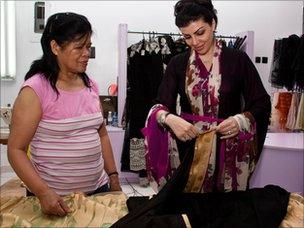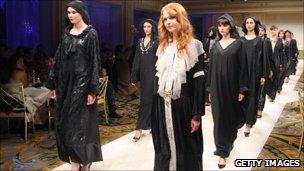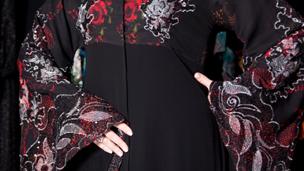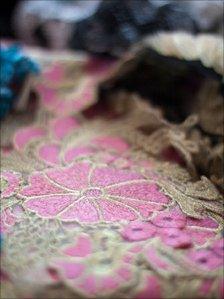Reinventing the Saudi abaya
- Published

Eman in the workshop with one of her dressmakers
When a woman is seen in public in Saudi Arabia, her body must be covered by a long flowing garment, an abaya. Traditionally these are plain black - but at least one designer has other ideas.
One of the first things that women coming to Saudi Arabia have to do is go abaya shopping.
The abaya is the long, black cloak that all women have to wear by law when out in public. It's different from the burka, which is also widely worn, as it leaves the face and hair uncovered.
Abayas have been around for thousands of years.
Bedouin tribes wore them for protection from the harsh weather conditions in the desert. Now though, they are associated with religion, and are worn by Muslim women to protect themselves not from the weather, but from the eyes of men.
Many foreign women living in Saudi find abayas uninspiring and cumbersome. The trailing material, designed to cover the ankles, has a tendency to get caught in doors and trolleys - an ambassador's wife told me she'd broken her toe twice tripping over it.
They can also be very hot. At the height of summer, temperatures in Saudi reach about 50C, so a long, dark robe is the last thing you feel like putting on.
But change may be coming.
At the exclusive shop run by designer Eman Al-Mandeel, I was taken aback by flashes of colour and exotic fabrics. Her abayas fully cover the body, but anonymous black cloaks they are not.
Quietly, over the past few years, an abaya evolution has been under way thanks to Eman and others.

Other designers are also putting a new twist on the traditional abaya
A talented painter, Eman began making her vibrant gowns 12 years ago when living in Dubai. There, as in some other parts of the Gulf, it's not unusual for women to wear navy blue or brown abayas, and her ideas fell on fertile ground.
Eman started wearing her own designs, and after a while people started asking her to make abayas for them.
Moving to Riyadh, one of Saudi Arabia's most conservative cities, it was far from clear whether there would be a market for her work. Here, black abayas with little or no embellishment are still the norm - but against the odds, Eman's creations have won lots of fans.
Many Saudi VIPs wear them - they are some of the few that can afford them. The average price is £250 ($400), and some designs sell for as much as three times that.
Religious police
Eman creates each one using bright fabrics she finds on her travels - silks from India, ribbons from the United States and lace from Dubai.
Eman now sells on average 55 abayas a month from her Riyadh shop. She invites her customers to choose from her materials, then creates a design that fits their style.

Eman's shop is for women only
But there are stories of the religious police, the Muttawa, confiscating colourful abayas. Is she worried about them coming into her shop, and telling her off for making her designs too eye-catching?
"Well, my shop is women only," she laughs. "So they cannot come in."
Then, she quickly and earnestly points out that she has no issue with the religious police. She respects their job and is aware of what is appropriate attire for Saudi women.
Eman believes she is not doing anything wrong by creating colourful clothes, she's just bringing the traditional abaya up to date.
Only two?
"All generations have worn abayas," she says. "We see how our mothers and grandmothers wear them.
"And each generation, we want to improve the style to fit with the times, while still remaining respectful to our culture.

She sources fabrics on her travels
"I want my abayas to be an extension of a woman's personality. They don't have to go away from their purpose to do that."
Many of her designs feature colours against a dark background - and sometimes the colours are very bright.
"You have different outfits for different occasions," she says.
"I would wear a bright one for a party and a less showy one for shopping.
"You see my abaya is what I want to show off to other women. I have more than 30."
I only have two, I tell her. She looks at me as though I'm deprived.
Eman wants more Saudi women to adopt colourful abayas as a statement of their identity.
"You can not change a country in one or two years," she says thoughtfully. "But each year I can see Saudis getting that little bit more accepting… My aim is to make Saudi women look like individual members of society."